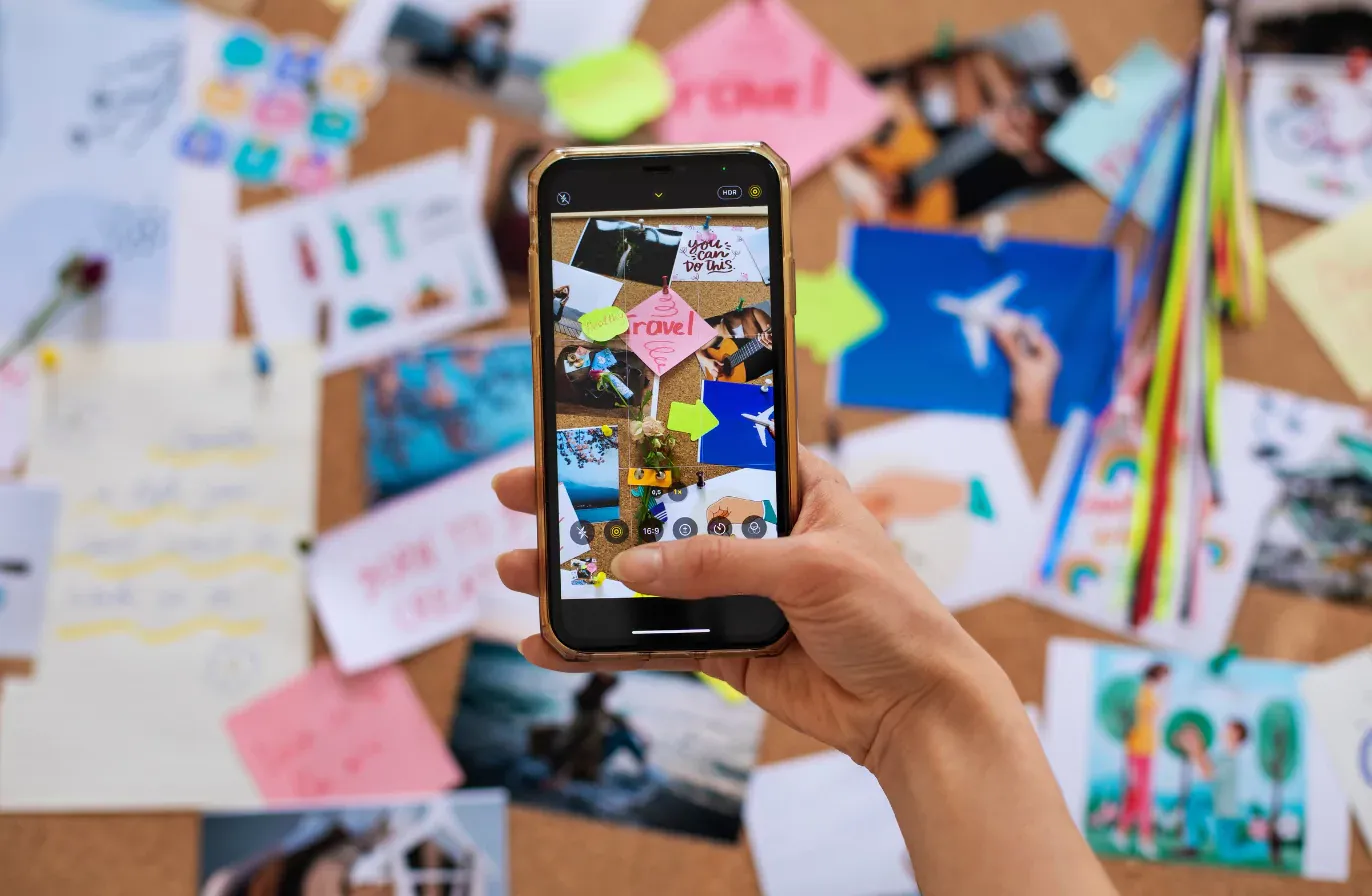Employee-Generated Content: Tips on How to Approach It And Successful Examples
Want to know how to leverage employee-generated content? Discover strategies on how to encourage it and examples with the most engaging types.

People relate to people. Not faceless brands.
This is partly a reason why we see more and more brands encouraging employee-generated content (EGC) as part of their social media strategy.
If you are someone like me who scrolls through social media for a living (literally), it’s difficult not to come across a day-in-the-life post, behind-the-scenes content, or employee journey post.
The best part? This social media content is no longer restricted to LinkedIn. EGC is everywhere—on TikTok, Instagram, Facebook, and even X.
In this guide, we’ll share everything you need to know about EGC. From what it really is to how to build a strategy for EGC, we will learn it all.
What is employee-generated content?
Employee-generated content (EGC) is any form of content, such as social media posts, podcasts, videos, or even memes, created and shared by a company's employees.
Businesses are using employees as brand ambassadors alongside traditional marketing strategies to boost brand trust and credibility.
For example, imagine your product designer sharing a TikTok about the brainstorming process behind a new feature, or your customer support rep tweeting about a heartwarming interaction with a client. This adds a human touch to your brand. And you manage to reach a wider audience through your employee’s following.
How does employee-generated content contribute to a business’s image?
Here are three ways in which encouraging employees to create content can help your company.
Boost brand awareness
Take these two statistics.
- Content shared by employees gets 8X more engagement than content shared through brand accounts.
- Employee posts get reshared up to 24 times more than a branded post.
This shows that by encouraging employees to create and share content, you can tap into a powerful yet organic way to expand your brand’s reach. Think of it like this. Employees are the new influencers. Except these influencers already know and love your company.
These employees have their own network of followers — friends, industry peers, potential customers, and even future hires. When they post about their work, experiences, or company culture regularly, they indirectly influence brand awareness and make your brand memorable.
Foster credibility and authenticity
Think of employee-generated content (EGC) as a word-of-mouth recommendation from a friend. It feels more real, trustworthy, and personal than branded content.
EGC is a subtle way of showing your company culture, the fun things you do at your office, the values you follow, and the different products/features your employees use.
Because this trusted content fits in naturally and comes from a human, it feels more authentic and credible.
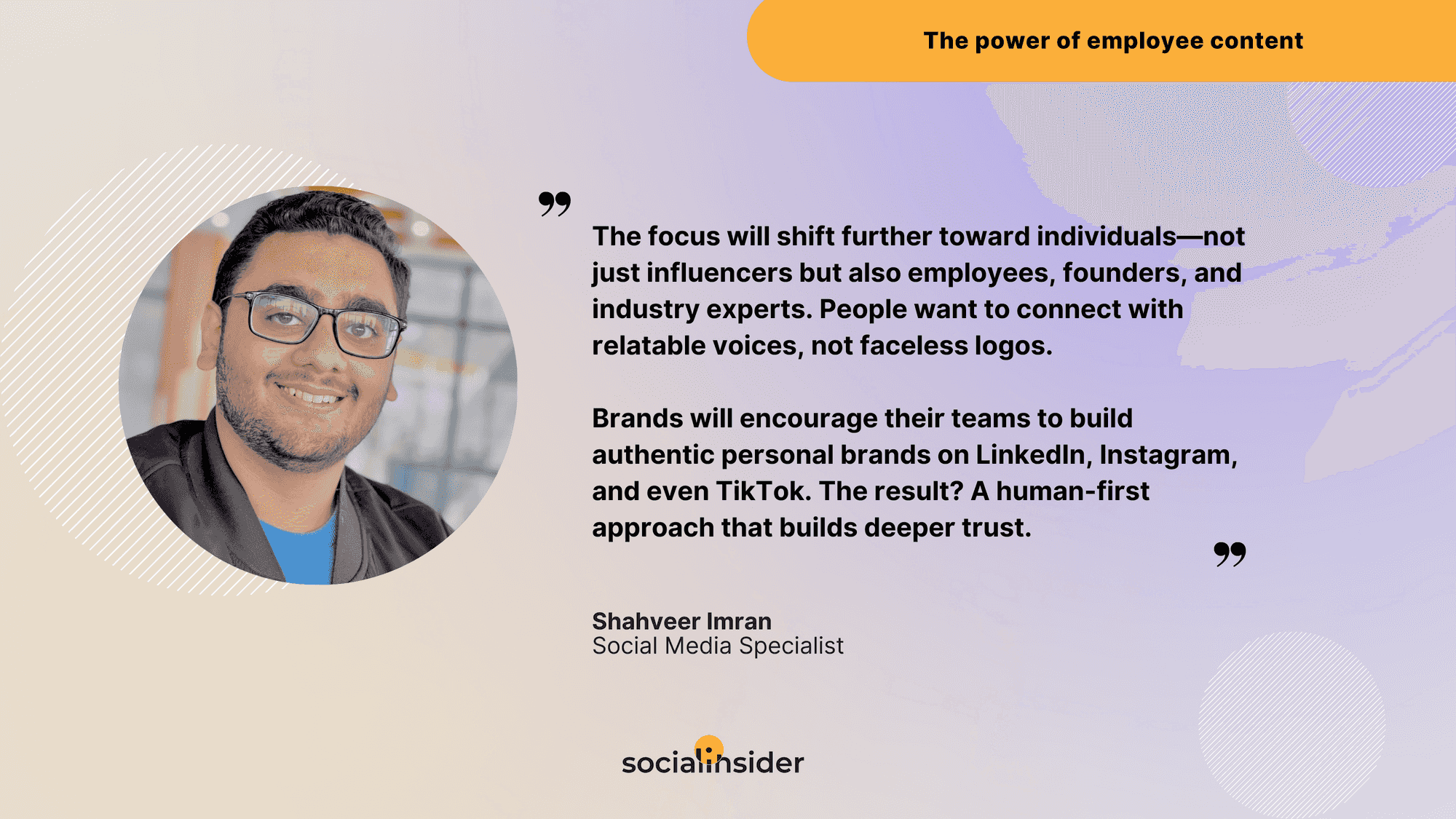
Strengthens employer branding and talent acquisition
When employees speak about their positive experiences working for your company, it speaks volumes compared to a traditional job ad. It builds an image of a company that is great to work for.
With 86% of job seekers using social media in their job search, powerful EGC can influence whether they want to apply for your company or not.
For example, which content would you trust more?
- Content A (Branded content): A company posts, “We’re a great place to work! Check out our amazing office culture.”
- Content B (EGC): An employee shares a LinkedIn post, “Just wrapped up an exciting brainstorming session with my team! Love how everyone’s ideas are valued here.”
Content B, right? That’s the power of EGC.
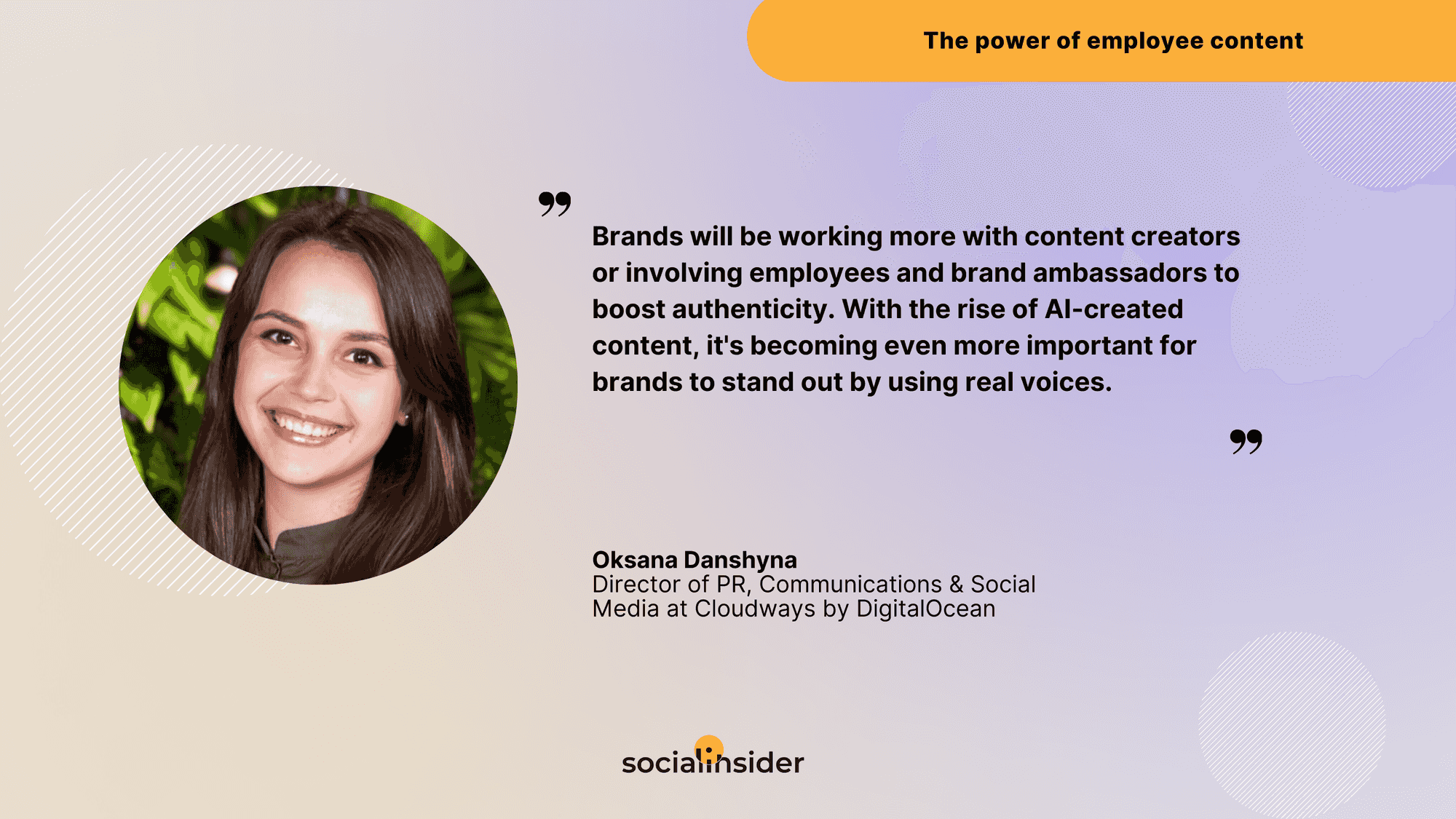
Types of employee-generated content
You don’t have to stick to one or two types of employee-generated content. Here are 11 types and examples of employee-generated content you can experiment with.
Job openings and referral shares
Want to get the best talent for your company? Don’t just share the opening on your website or career sites.
Ask your employees, especially those who will work directly with the new hire, to share this job opening on their social platforms. Instead of just sharing the application link, ask your employees to include details like:
- A sentence about why they love working there or what makes the team special;
- A brief story about their experience working for the company;
- What the growth trajectory might look like;
- An invite to reach out for queries/doubts;
- Engaging media to go with the text-only post.
Here’s how Dina AbdelWahab shares a hiring post for IBM.
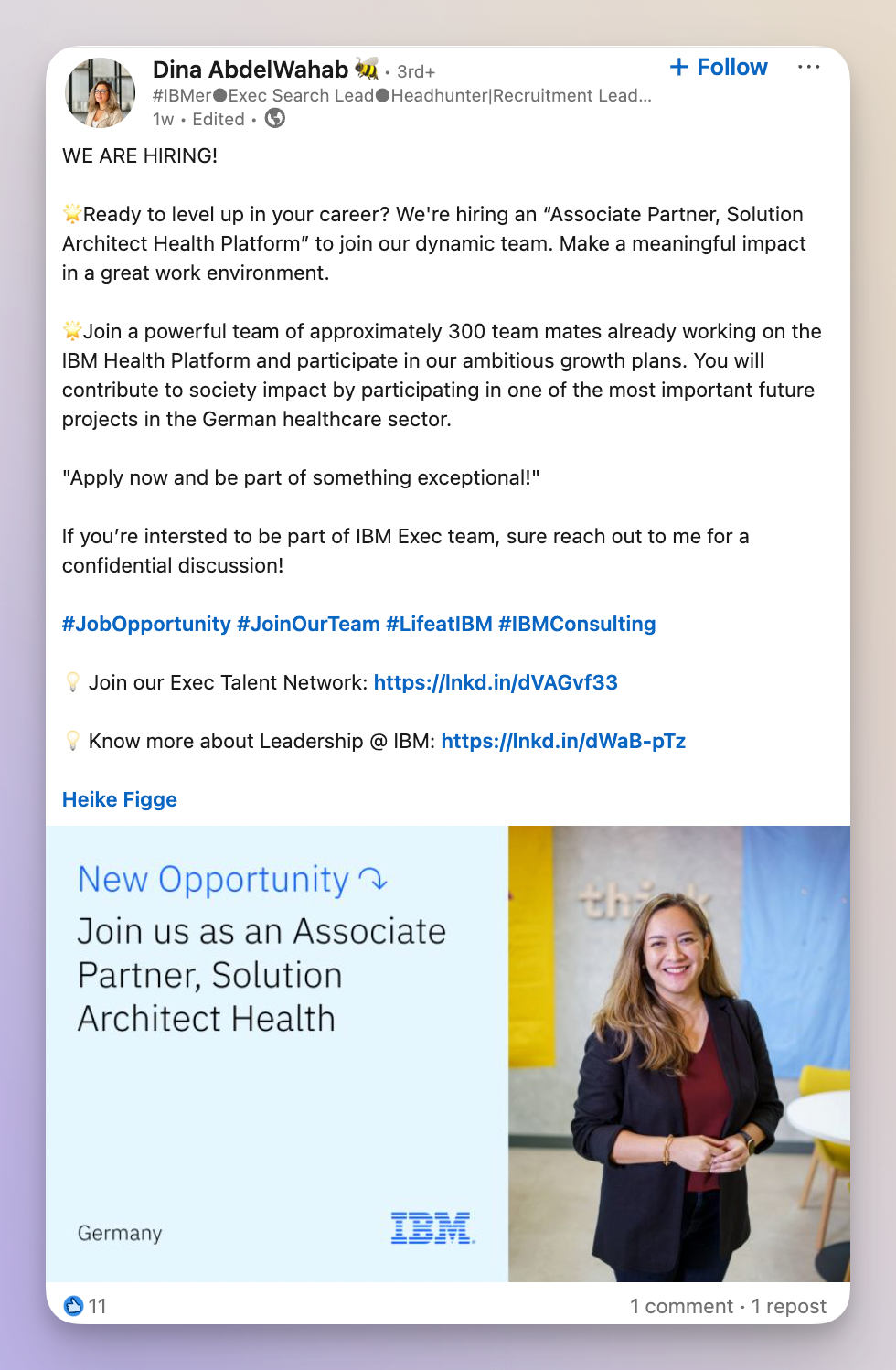
Why does this type of EGC work?
- A job opening shared by an employee feels more personal and credible than a corporate job ad.
- Employees have unique networks that may not overlap with the company’s audience.
- This helps you tap into fresh talent pools.
- Employee referral programs reduce hiring costs by minimizing the need for expensive job ads and external recruiters.
Work anniversaries and milestones
This is one of the most popular types of EGC because employees love to share their milestones and achievements with others. This content could be about a promotion, a year of being associated with the company, or goals that they hit.
This creates a culture of recognition, attracts top talent, and strengthens company credibility.
Here’s how Eric Henriquez, sales recruiter at HubSpot, talks about completing one month at HubSpot and what that month looked like.
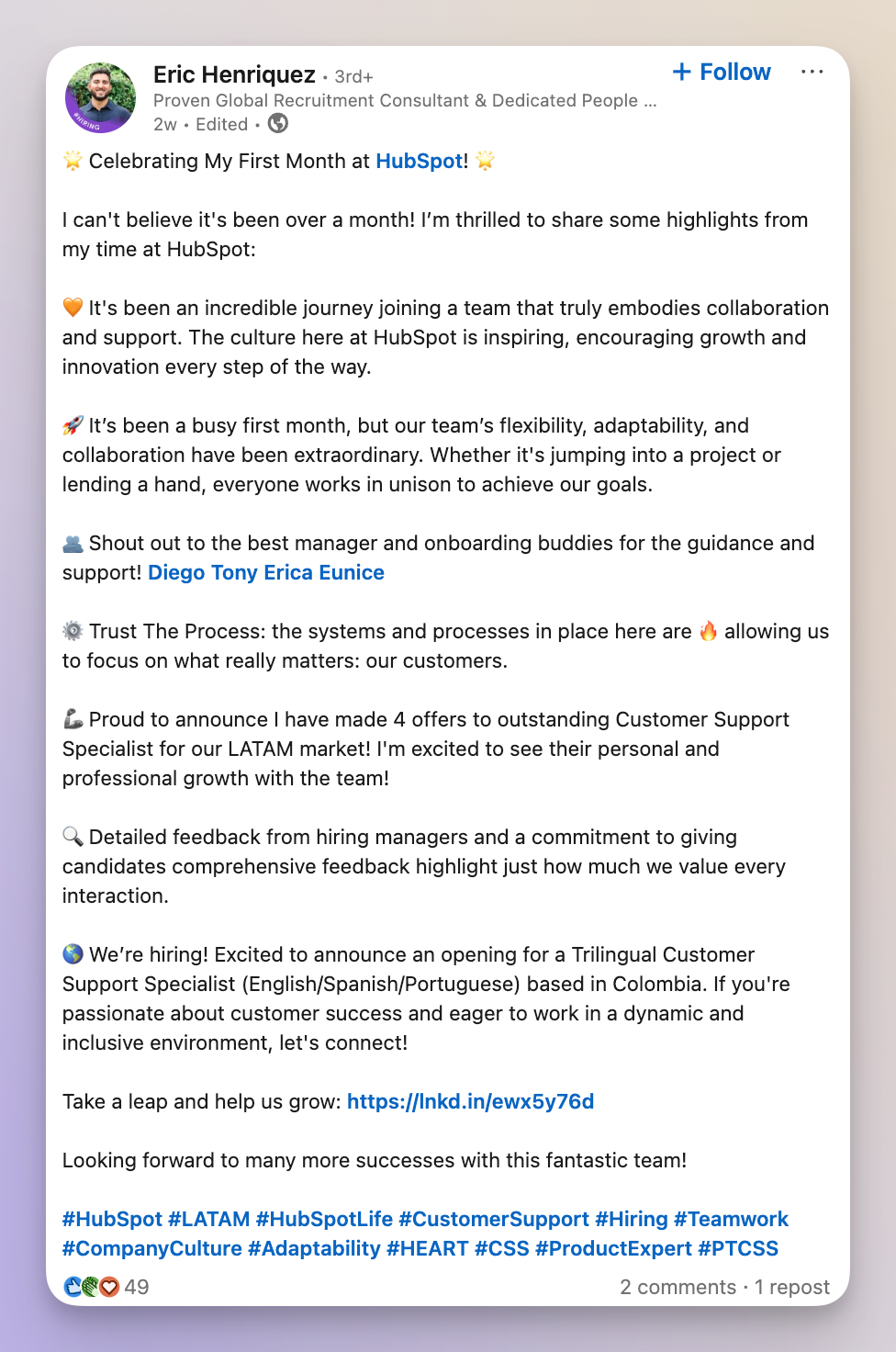
Why does this type of EGC work?
- A post from an employee celebrating their time at a company acts as an endorsement of the workplace, showing job seekers and clients that people enjoy working there.
- Work anniversary posts often get high engagement, with colleagues, peers, and company leaders joining in to celebrate, boosting visibility for your company.
- It promotes a growth mindset, motivating employees to set and achieve goals.
A day-in-the-life post
People are naturally curious about what a person actually does day-to-day, beyond just a job title.
What does a typical workday look like? What kind of tasks and challenges do employees handle? How do they collaborate with their teams?
Employees can highlight team interactions, office perks, flexible work schedules, or even their work-from-home setup. Many also use these posts to showcase company culture, whether it’s bonding over lunch, enjoying a game in the office sports area, or sharing funny Slack conversations with teammates.
Here’s how Maggie talks about what it’s like to intern at Google.
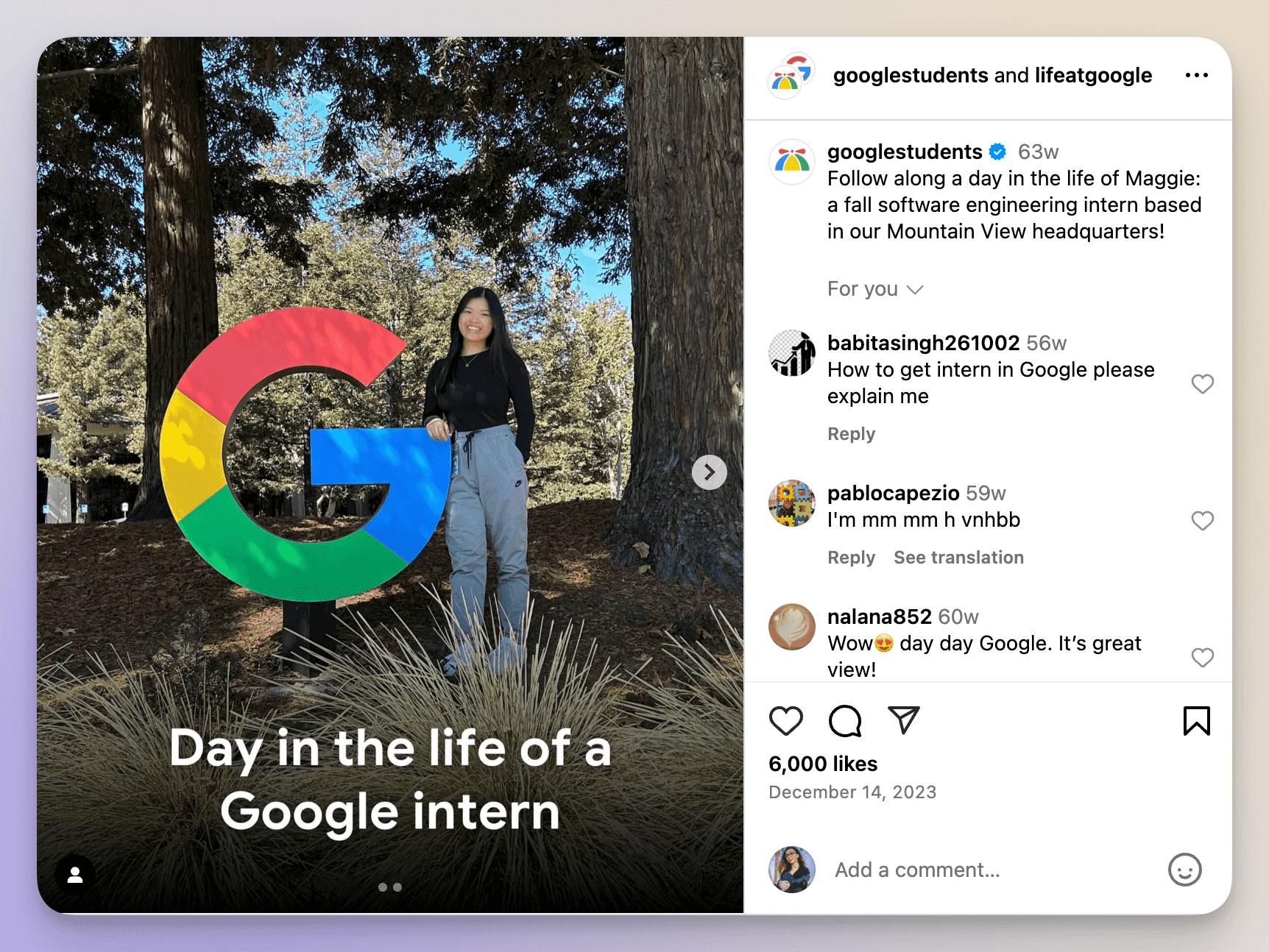
Why does this type of EGC work?
- Gives potential hires a real glimpse into the company culture, daily tasks, and work environment.
- This EGC with storytelling elements gets higher engagement than standard promotional posts.
- These posts are generally visually appealing, and they grab attention faster.
Celebration of values
Are your company values just sitting on a page of your company website? Or is it getting mentioned only during onboarding?
EGC can help change that. When employees actively share how they see company values in action, those values become more than just words. Think of it as the difference between reading a company’s mission statement and actually seeing employees embody that mission in their work.
For example, look at how Carolina Caparros gives a shout-out to the hybrid policy at HubSpot. She adds, “As our culture code states, work isn’t a place we go but a thing we do.”
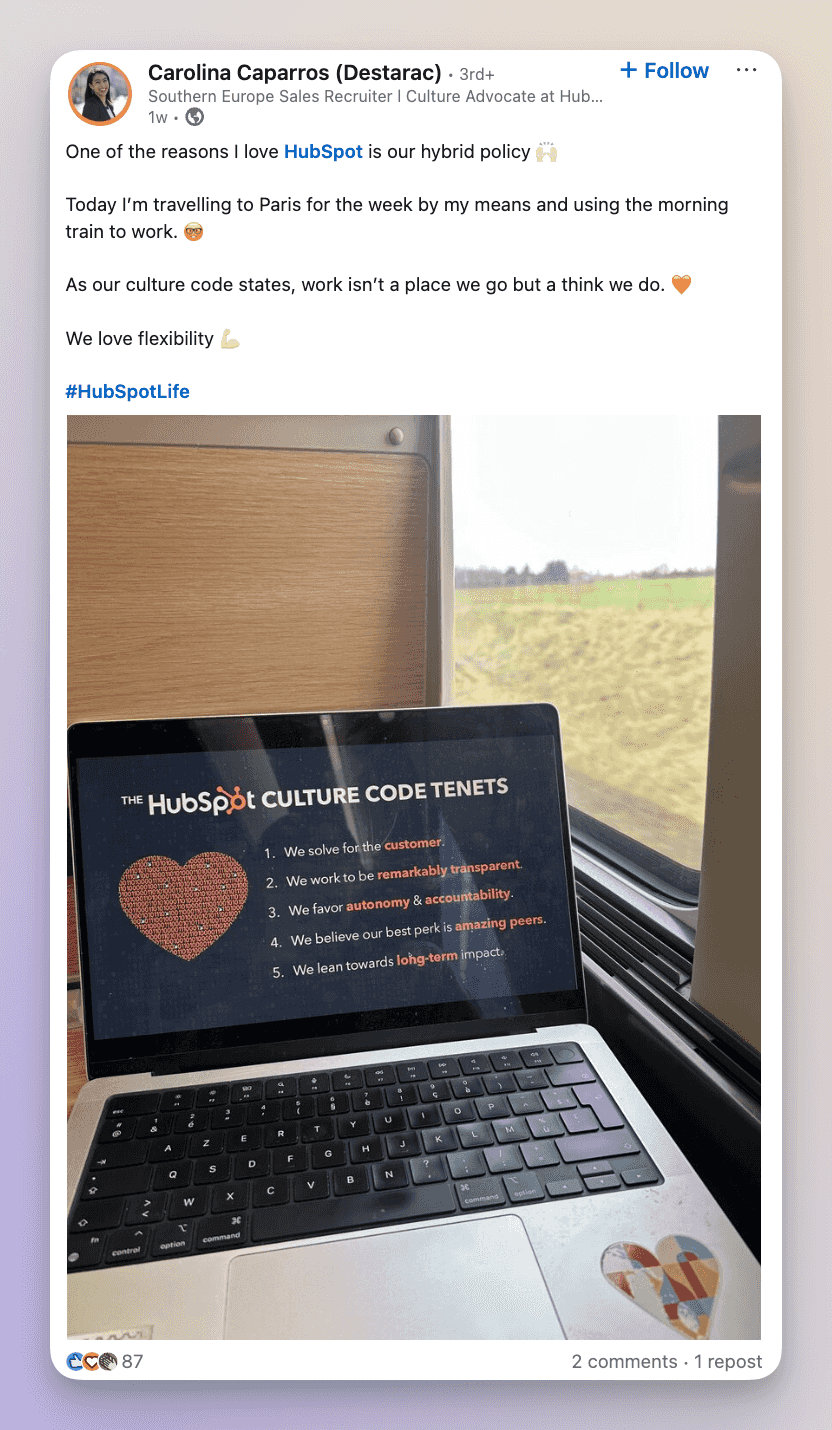
Why does this type of EGC work?
- Candidates want to work for companies that genuinely uphold their values. This helps you create a strong employer brand.
- When one employee shares a story about how the company lives its values, it inspires others to do the same.
- When employees post about values like sustainability, integrity, or corporate responsibility, it boosts the company’s public image.
Employee testimonials
Employee testimonials act as social proof for customers and potential hires.
It could be of two types.
- Workplace experience testimonials: Employees share why they love working for the company, highlighting aspects such as career growth, leadership support, work-life balance, or company culture.
- Product/service advocacy: Employees speak about the benefits of the company’s offerings from an insider’s perspective, showing their belief in the brand.
Here’s how Valentina Gallego shares her testimonial about working at HubSpot.
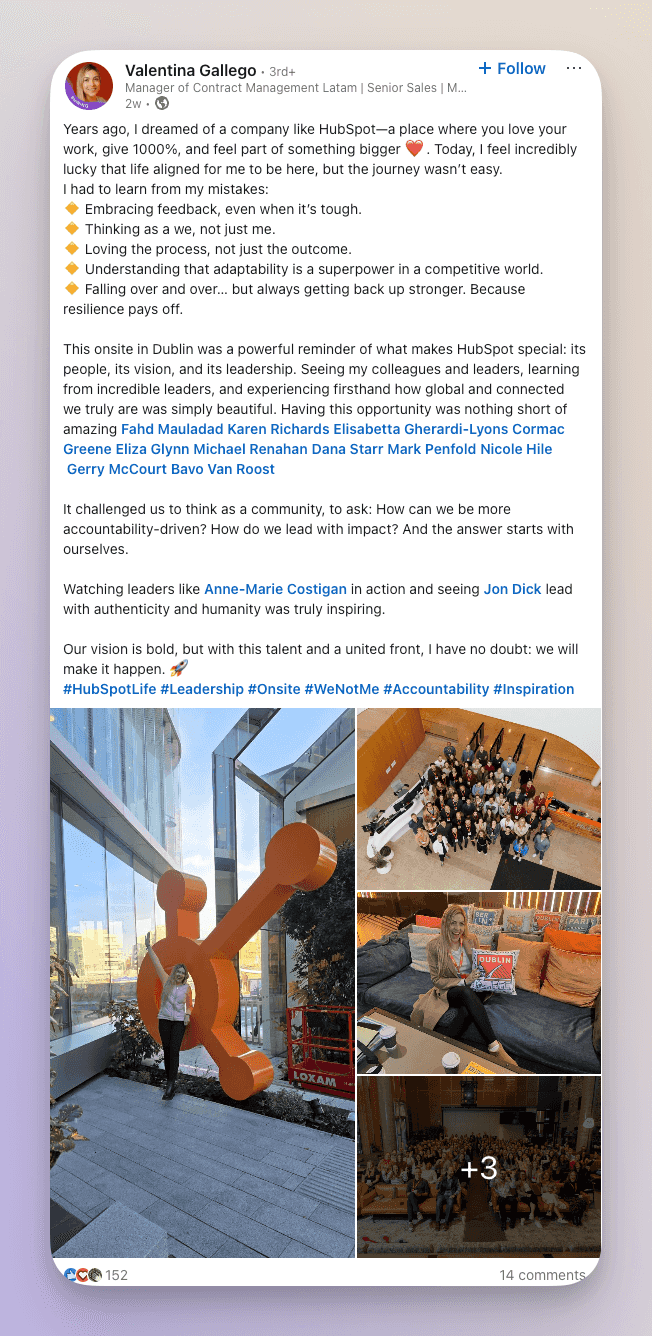
Why does this type of EGC work?
- Employees sharing their experiences makes the company feel more relatable and transparent.
- Employees endorsing products or services and possibly showing the product in action adds an extra layer of trust and reliability.
Company achievements
When a company reaches a milestone, wins an award, or achieves something remarkable, it’s not just a corporate success. It’s a collective achievement that employees take pride in.
This could be something as big as raising funding or something as small as launching a new internal initiative.
The more employees volunteer to create this EGC, the more it amplifies the company’s reputation.
Here’s how Sebastian Scharf-Barak shares the news about the employee-led family group building a new parent-child room at Microsoft’s Frankfurt office.
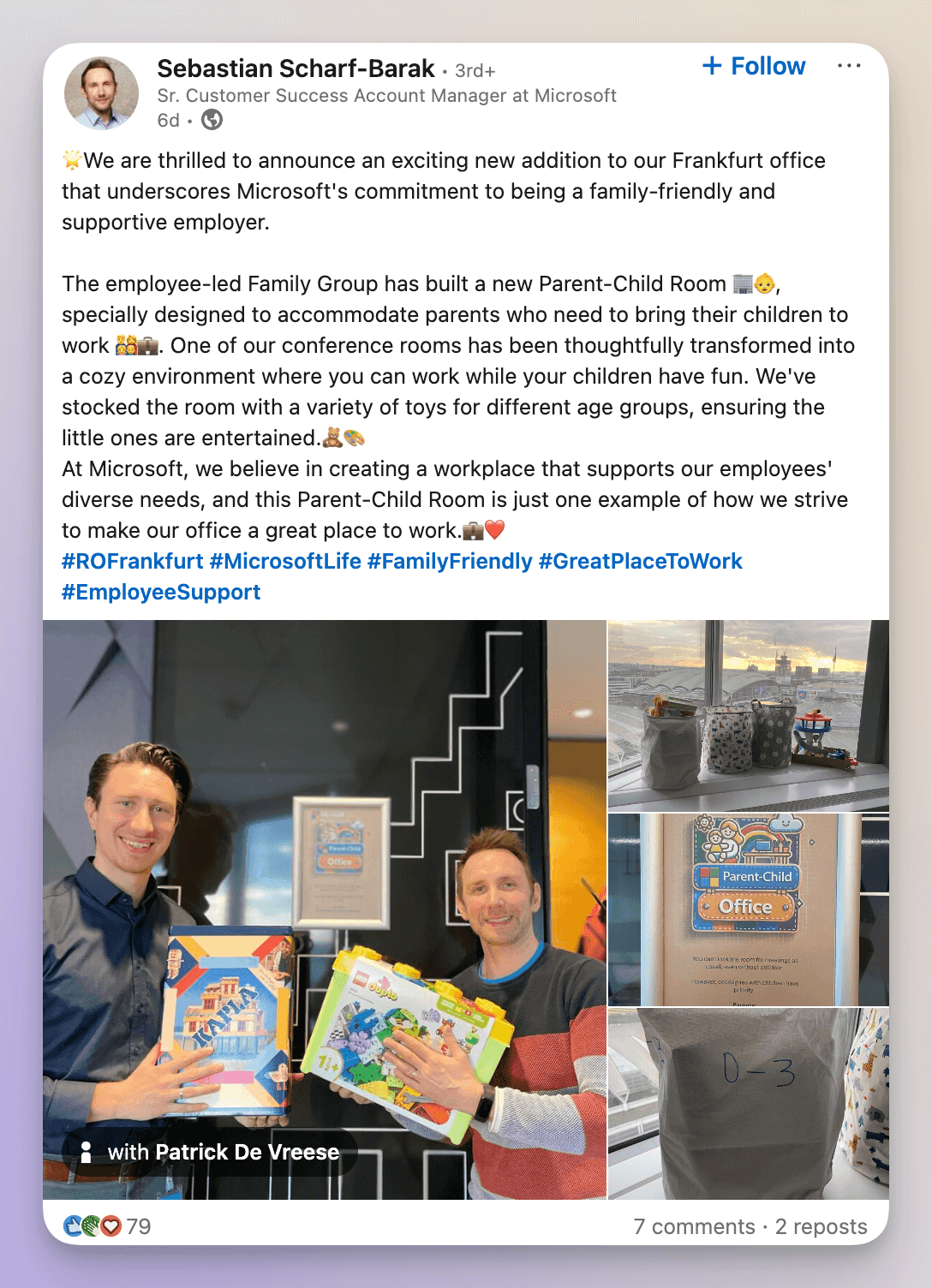
Why does this type of EGC work?
- A company announcing its own achievement can feel like bragging, but when employees share it, it becomes a genuine moment of excitement and pride.
- Seeing employees genuinely proud of where they work makes a company more desirable to potential hires.
- Employees sharing company achievements with their personal networks extends the company’s reach far beyond corporate channels.
Expert advice
Have you ever read a LinkedIn post from an industry expert that completely changed your perspective? Or watched a quick tutorial that solved a problem you’ve been struggling with?
Chances are that content came from an employee sharing their expertise and not a corporate brand.
When your employees share their expert advice on social media, they build their personal brand. When this personal brand grows, its reputation also benefits the company's image.
Take how our social media manager at Socialinsider, Miruna Vocheci, talks about the stats from our social media benchmarks report.
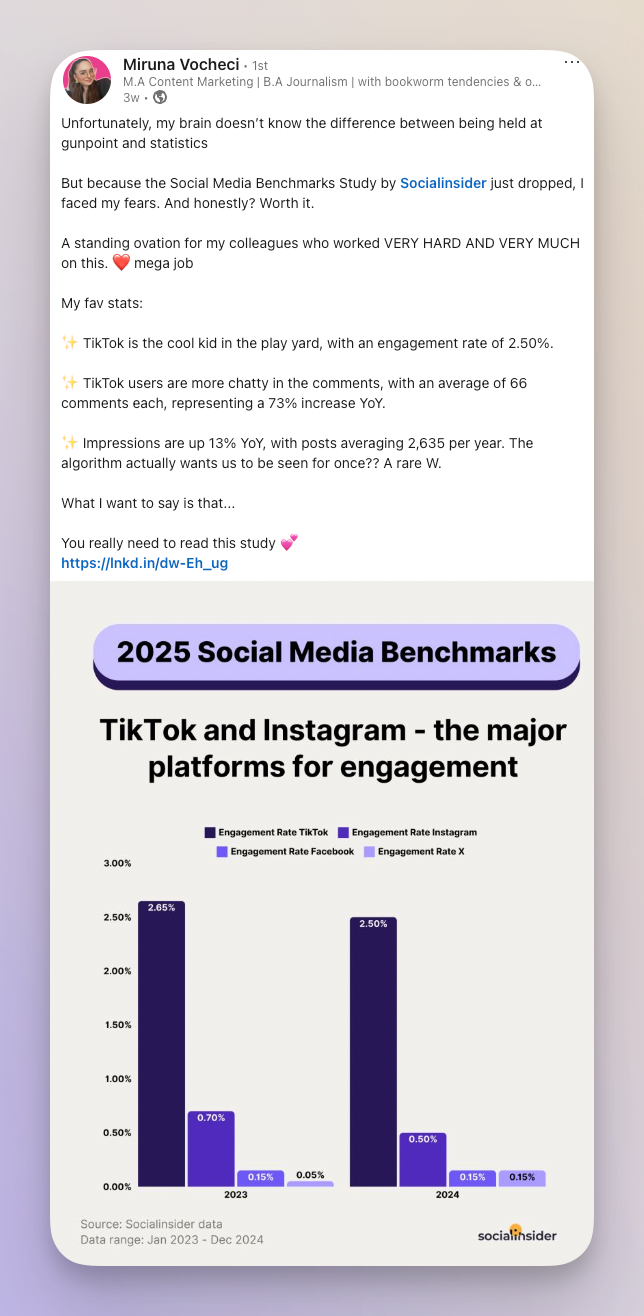
Why does this type of EGC work?
- Educational, opinionated content naturally gets shared, helping brands reach wider audiences.
- Thought leadership content can spark conversations with decision-makers and industry peers. This can get brand attention from the right people.
- Employees sharing knowledge online inspires internal learning and helps build a culture where knowledge gets transferred easily.
Employee's journeys
Not everyone in your company has had a linear career trajectory. Some may have jumped fields, while others may have had a very inspiring journey. Why not encourage them to share these stories?
These employee journey posts take people behind the scenes of what it’s like to work at a company/specific role, from first-day experiences to big career milestones.
When employees share these journeys, they showcase not only their own success but also the company as a place where people thrive and grow.
In this post by IBM, Alexandra shares her journey of being a consultant and how IBM has helped shape her career.
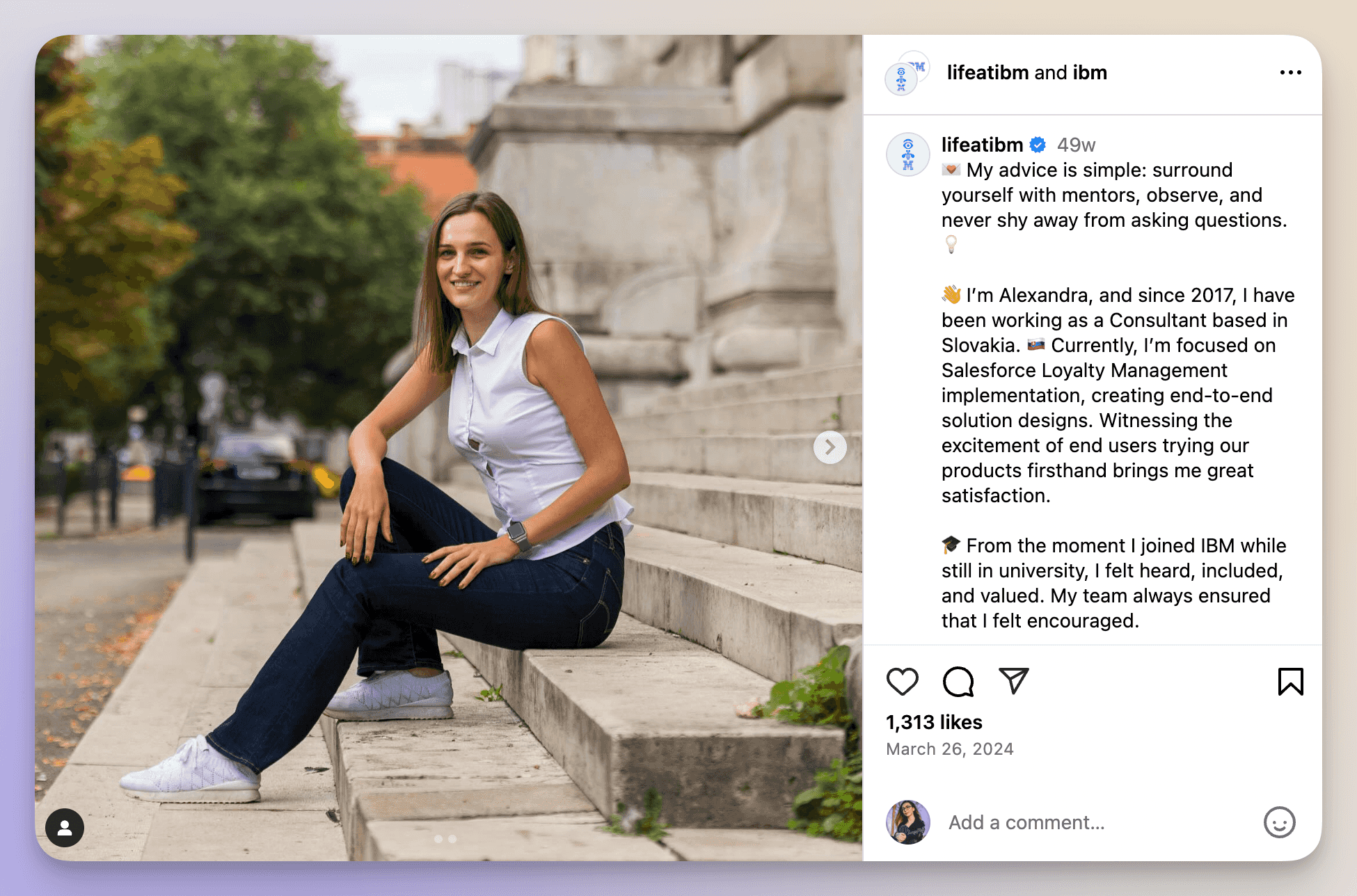
Why does this type of EGC work?
- Highlighting promotions, lateral moves, and skill development proves that employees aren’t stuck; they’re constantly evolving.
- When employees talk about their journey, it shows the company’s commitment to professional growth.
- Employee journeys highlight what makes your company unique, giving you a competitive hiring edge.
Behind-the-scenes
People love getting a sneak peek into their dream companies’ workplaces. Whether it’s how teams collaborate, products get made, or just the fun moments that happen every day, this content is engaging because it feels raw and unscripted.
Think about it. A brand announcing a product launch is one thing, but seeing employees testing, brainstorming, or celebrating the process makes it more exciting and relatable.
Many employees also create behind-the-scenes content for events, celebrations, and conferences.
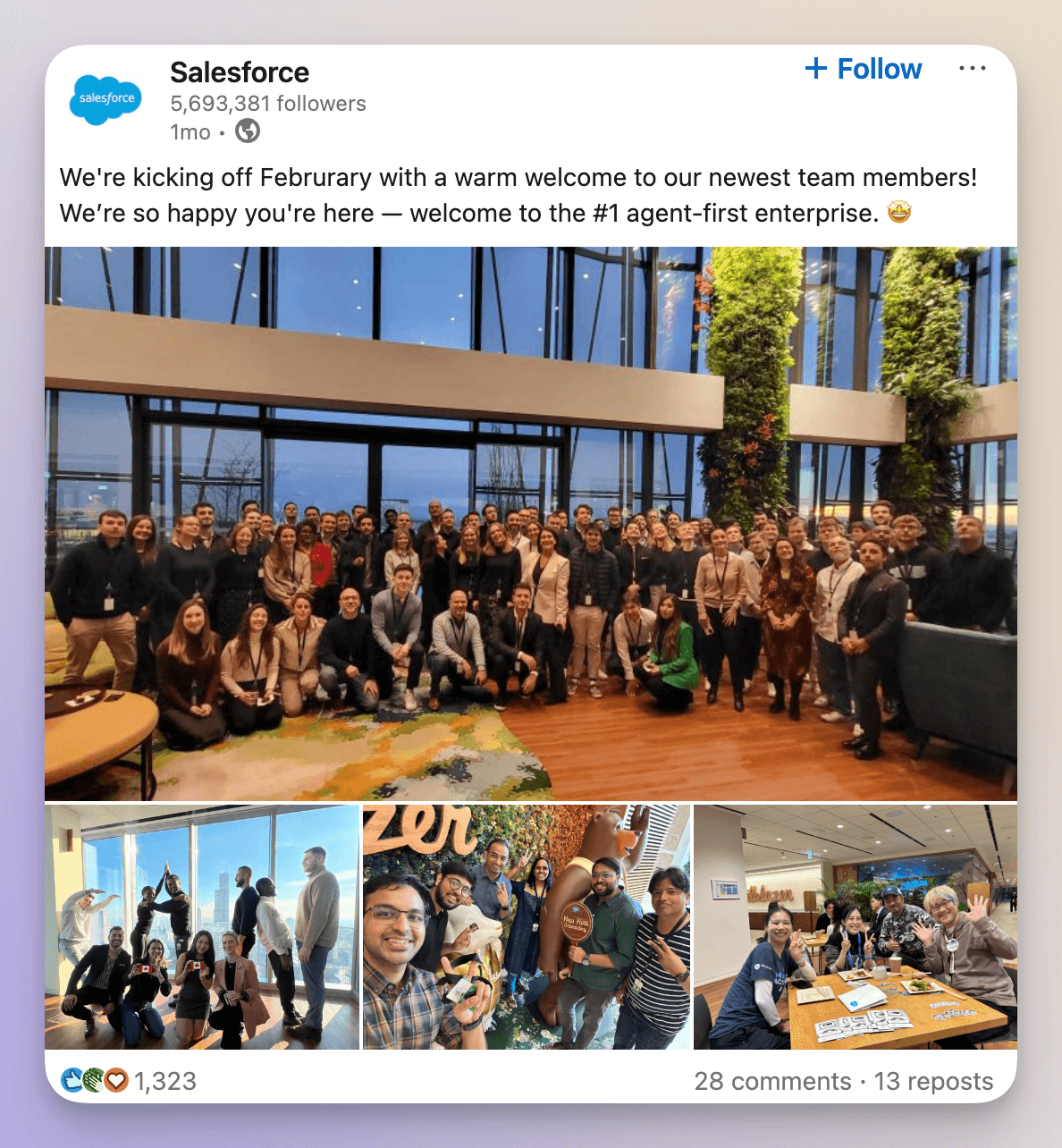
Why does this type of EGC work?
- BTS posts often get higher engagement because they are lighthearted, visual, and fun to watch and share.
- BTS content shines a light on your culture and team bonding in the workplace, showing that work can be both productive and enjoyable.
- A strong BTS strategy can help a company stand out as a transparent, fun, and inspiring place to work.
Workplace culture and moments
A company is a lot more than just a place to work. From team lunches to inside jokes, brainstorming sessions to company traditions, these small but meaningful moments shape the work experience.
And that’s what this EGC is all about. These posts could be about celebrating a teammate’s birthday, participating in a fun challenge, or simply enjoying the workspace vibe.
For example, our team came together for a fun activity where they answered the question — What would they like to say ‘No’ to this week?
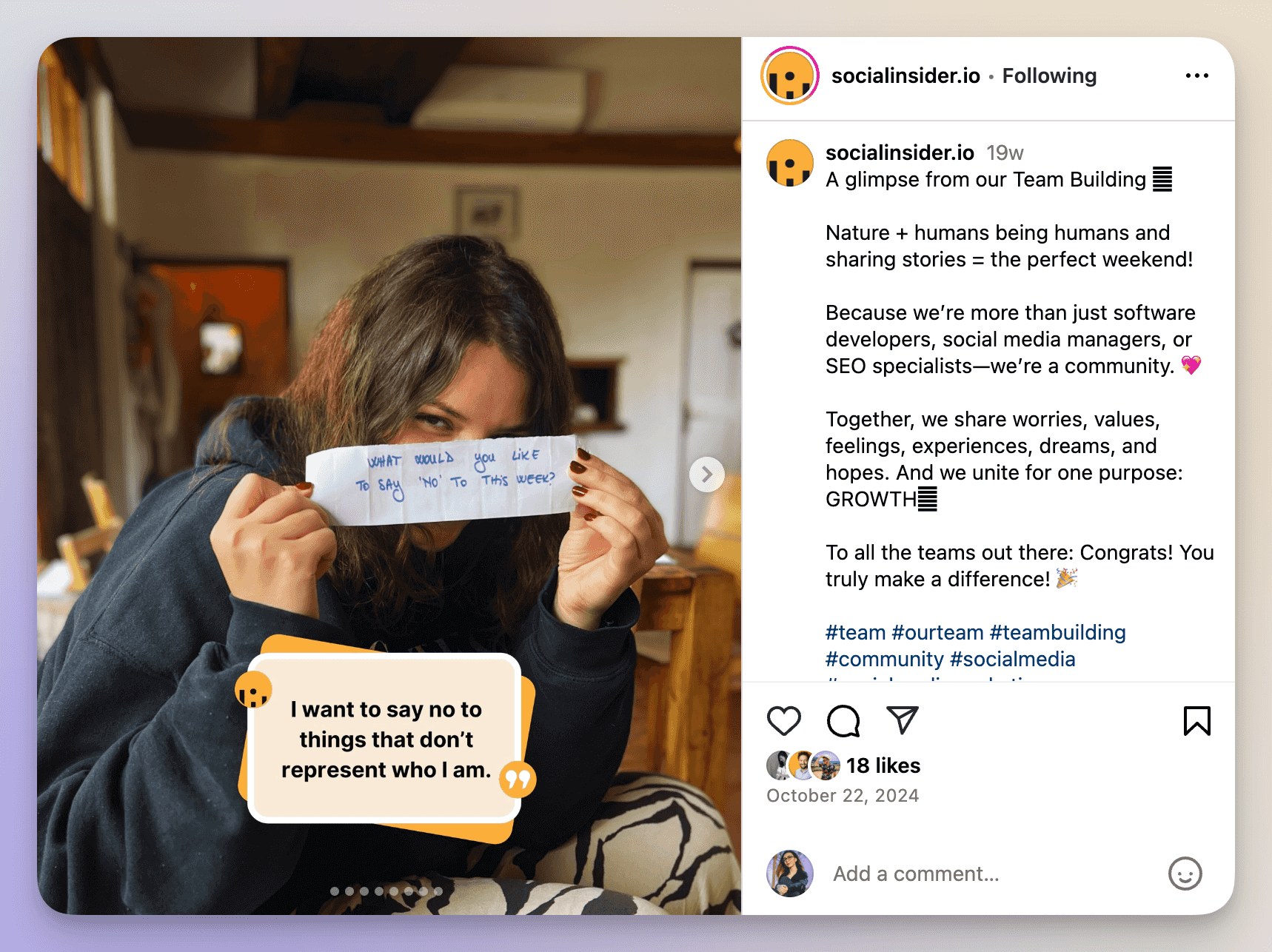
Why does this type of EGC work?
- Sharing moments like team lunches, office jokes, and celebrations shows that the company values its people.
- When employees share authentic workplace moments, it helps attract people who align with the company’s values and vibe.
- Culture posts don’t just highlight individual teams. They show how different departments collaborate and support each other.
Employee recognition
Who doesn’t love a little appreciation? When employees feel valued, they’re more engaged, motivated, and proud of where they work. Employee recognition posts are a powerful form of EGC that celebrates achievements, hard work, and milestones.
A simple shoutout can make a big difference, and when it’s shared publicly, it boosts morale and also builds a company culture where appreciation is the norm.
In this post, Andrew from IBM’s Egypt team is recognized for his work.
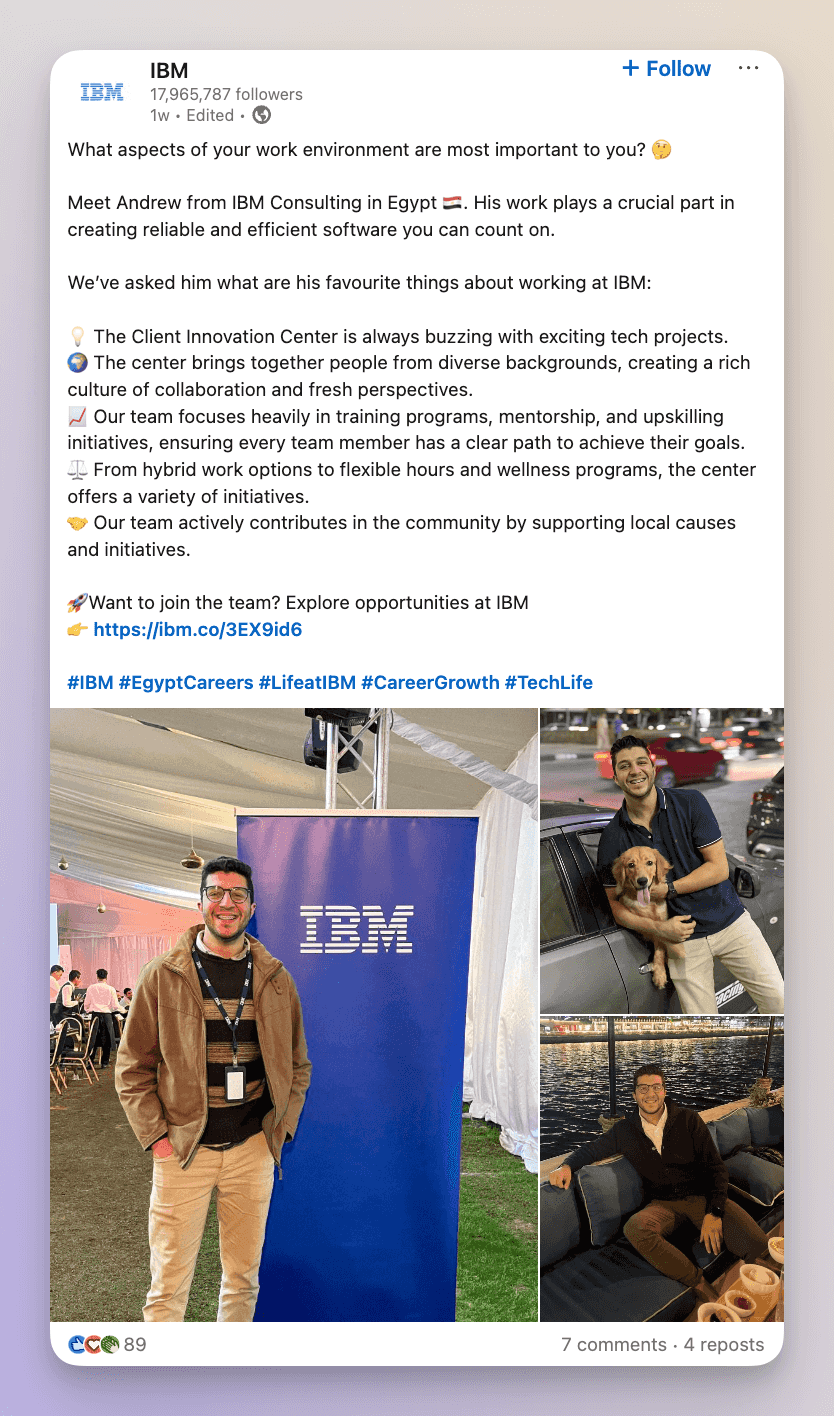
- Public appreciation makes employees feel valued and motivated. This boosts employee morale.
- When employees see their peers getting recognized, they’re inspired to go the extra mile.
- When prospective hires see a workplace where hard work is celebrated, it makes the company more appealing and strengthens employer branding.
How to build an employee advocacy program?
You can encourage employee-generated content. But how do you give it direction and keep motivating employees to create content?
One simple way is to build an employee advocacy program. Here’s how to do it in six steps.
#1. Set clear objectives and KPIs for your EGC program
Before you encourage your employees to generate EGC, figure out “why” you’re even asking them.
Is it to attract more talent to your open roles? Or increase brand awareness on social media?
This goal will guide the type of content you will want the employees to create. And the KPIs you track. For example, if you are trying to boost brand awareness, you might track metrics like reach, impressions, and shares on social media.
Other valuable metrics include:
- Top contributors: Identify employees driving the most engagement.
- Click-through rates: See how well posts convert interest into action.
- Content performance: Understand which formats (videos, testimonials, day-in-the-life posts) resonate most.
With clear KPIs in place, you lay the foundation for a successful employee advocacy program. And your employees are driven to create content that is tied to goals.
#2. Announce the initiative
The objectives are set. It’s time to create enthusiasm around this program among your employees.
Start by announcing the initiative and focusing on three aspects.
- What is the program about?
- Why should employees participate?
- How can they get involved?
You can do this through a company-wide email, an internal meeting, or a Slack channel message.
For example, when Carmen Vicente, social media manager at Gorgias, launched the EA program, she decided to forego a software tool in the beginning. She just created a Slack channel to centralize all communication around the EA program. Anyone who wished to participate was invited to the channel.
While announcing the initiative, she also made sure the employees were incentivized to participate.
Below, you'll see how she described the strategy behind the program:
We offer two (modest) gift card incentives but in the end I don't think they've dazzled all that much. So, I built a solid case for how much this bolsters their personal brands, and everyone (who's joined) is motivated by that.
People understand how important career visibility is in today's age, so once we make that connection, participation seems to flow.
It's not without challenges in motivation and bandwidth, but I do swoop in quite a bit to cheerlead, keep folks accountable, and get my hands dirty with 1:1 content sessions of editing assists.
#3. Provide requirements and expected completed actions
Once the employees know about the program, the next step is clarity. What exactly do you expect from them? Without clear guidelines, participation can feel overwhelming or confusing.
Here are some guidelines you can establish.
- What type of content should employees share: Company updates, job openings, work culture moments, behind-the-scenes insights, or industry-related posts?
- How often should they participate: Weekly, bi-weekly, or as opportunities arise?
- Where to share: LinkedIn, Twitter, Instagram, or other relevant platforms.
For example, Carmen formulated one simple goal for anyone who wished to participate: create two work-related LinkedIn posts per month, with no guardrails on topics or word count.
The completed actions involved the employees sharing the engagement metrics of those posts with her.
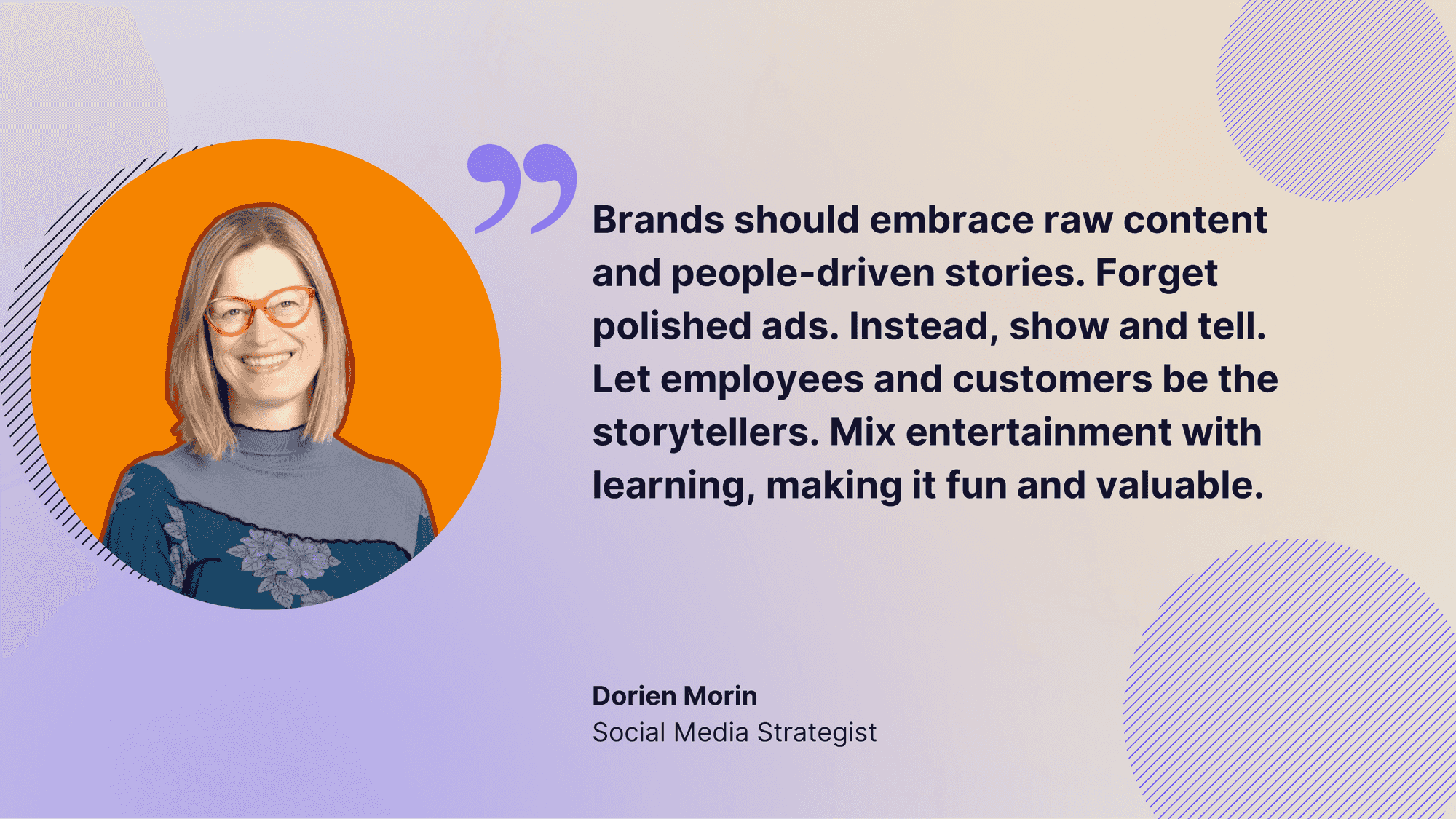
#4. Offer resources and guidance
Your employees may have a lot of expertise and unique insights to share. But they still might not know how to craft their posts in a compelling way. Or how the algorithm works. It’s your role to give them the right resources and support needed to succeed.
Some examples of resources that you can provide:
- Best practices on how to write engaging posts, such as using top-performing content formats.
- Content inspiration and prompts.
- Branded assets like high-quality product images, templates, and videos that employees can use.
The best way to provide these resources is to create a central hub.
For example, Carmen created a Notion doc that had all key resources like post starters, hook strategy, navigating the LinkedIn algorithm, and a couple of Loom videos. She also provides 1:1 support to help employees create EGC posts and succeed with their personal branding.
#5. Have a monthly analysis
What you don’t track, you don’t improve. You might have given your employees all the resources. But their posts might still not be bringing the desired reach or engagement.
Some of the social media metrics you should track are engagement metrics, content performance, and traffic & conversions.
Don’t just stop there. Use this data to:
- Identify trends: See what kind of content from employees is engaging the audience the most.
- Recognize and reward top advocates: Acknowledge employees who are actively contributing.
- Optimize strategy: If certain content isn’t performing well, adjust your content strategy with new formats or better guidance.
Create a report based on these insights and share it with your employees. This will keep them engaged, show them their impact, and motivate them to keep participating.
For example, the employee advocacy program plan that Carmen executed brought the following results in just 6 weeks:
- 19 members
- 43 EAP published posts
- More than 560K total impressions
#6. Invest budget and resources for a longer plan
Creating an employee advocacy program isn’t the most difficult bit. It’s about how to manage an employee advocacy program that is challenging.
Carmen mentions in her LinkedIn post:
My feeling is that employee advocacy, like most kinds of content, is all about compounding interest, so the real benefits (and biggest hurdles) are yet to come.
And we agree. A successful social media employee advocacy program isn’t a one-time effort. It requires long-term investment to keep employees engaged and ensure consistent impact.
Here’s where we suggest investing your budget and resources:
- Incentives: Recognize top contributors with bonuses, gift cards, shoutouts, or exclusive perks.
- Training and development: Host workshops on personal branding, content creation, and social media best practices.
- Community building: Organize networking events, mentorship programs, or team challenges to keep employees engaged.
How to encourage employee participation?
You have an employee advocacy program in place, and all the resources have been finalized. Now, it’s entirely up to you to encourage your employees to participate in it.
Here are five strategies you can try.
Overcome common barriers to employee content creation
Many employees hesitate to create content for a number of reasons. They could lack time, fear saying the wrong thing, or simply not know what to post.
You can try the following way-outs for each of these barriers.
- Lack of time — provide ready-to-share templates and encourage micro-content such as short posts or a quick photo.
- Fear saying the wrong thing — encourage personal stories or share examples of what works for them.
- Not knowing what to post — share content ideas, create a repository of shareable company updates and news, and highlight trending topics.
Create incentive programs that actually work
Not every employee would want recognition. Some may prefer monetary rewards or career growth opportunities. You can design your rewards accordingly. For example, you can use a combination of bonuses, gift cards, exclusive perks, extra time off, or public shoutouts.
You can even keep the program fresh by rotating incentives to keep everyone included and engaged.
Pro-tip: Instead of just giving incentives, explain why personal branding is important for their careers and how EGC can help them create content that showcases their expertise in the industry.
Train and empower employees to create quality content
Want employees to create great content? Make it easy and fun. Start by hosting simple training sessions along with fun events.
For example, host a Lunch & Learn session where employees can get tips on how to create quality content from their social media manager.
Once EGC keeps pouring in, share the best content within your Slack channels and explain what made it great. This gives inspiration to other employees.
Also, train them on how to use certain tools to make content creation easier. For example, using Canva for templates they can tweak, CapCut for easy video editing, etc.
Build content creation into employee development plans
Want employees to create content consistently? Make it part of their growth journey.
Instead of treating employee-generated content (EGC) as an extra task, incorporate it into development plans. Encourage employees to share insights about their expertise, leadership growth, or industry trends.
When EGC is tied to career growth and recognition, employees are more likely to participate.
Recognize and celebrate employee content creators
Just sending a personal message like “Loved this post” or “You’re doing great” will not do much. Here are four ways we celebrate our EGC creators.
- Feature them on company channels. Highlight top employee posts on social media or newsletters. A simple “Employee Spotlight” can go a long way.
- A shoutout in a team meeting, a Slack channel message, or even a thank-you from leadership can make a big impact.
- Create a leadership board where you feature top contributors and reward them with small perks like company swag, gift cards, or LinkedIn endorsements.
- Turn their content into case studies. Show how their posts positively impact brand awareness, recruitment, or engagement.
How to manage risks and challenges?
Encouraging employee-generated content is great. But it also comes with a few risks. Here’s how to deal with them.
- Address legal considerations and intellectual property: Educate employees on copyright laws, content ownership, and disclosure requirements to prevent legal issues.
- Maintain brand consistency while encouraging authenticity: Provide brand guidelines that give a direction but let employees share their personal takes and opinions on different topics.
- Handle sensitive information and confidentiality: Educate employees on what internal information should remain private to avoid accidental leaks.
- Make plans for crisis management: If employee-generated content goes wrong, have a response plan in place to address miscommunications or controversial content quickly.
- Build a review process that doesn’t stifle creativity: Have an approval process, but don’t make it too restrictive. Encourage unique content ideas and topics.
How to measure the effectiveness of employee-generated content?
The simplest way is to track the metrics of your employee-generated content. It will give you a clear picture of whether it is working.
For example, as mentioned earlier, track the metrics from individuals’ posts. You can do this by asking your employees to send screenshots or input data into your spreadsheet.
At the same time, we also suggest tracking metrics of employee content that gets featured on your company’s pages.
To avoid wasting too much time scrolling through numerous social media posts across platforms and manually gathering all the insights you need, we suggest using tools such as Socialinsider to automate this reporting task.
With Socialinsider, you can manually assign a tag to each post from your business page that features an employee and create a content pillar for which you can analyze performance.
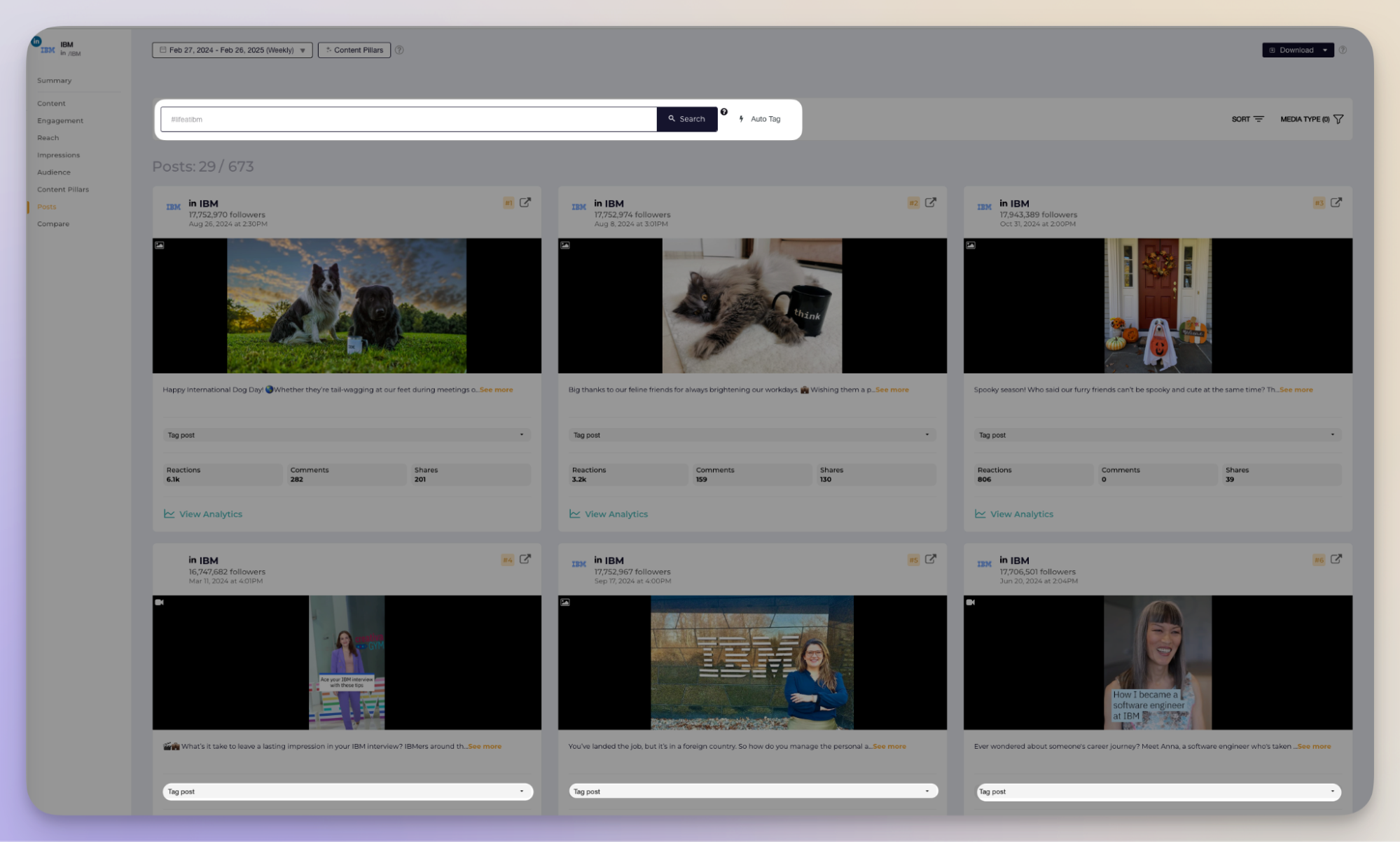
This performance analysis is available both at a content pillar level and also at a post level, in case you want to dive deeper into a particular post's performance.
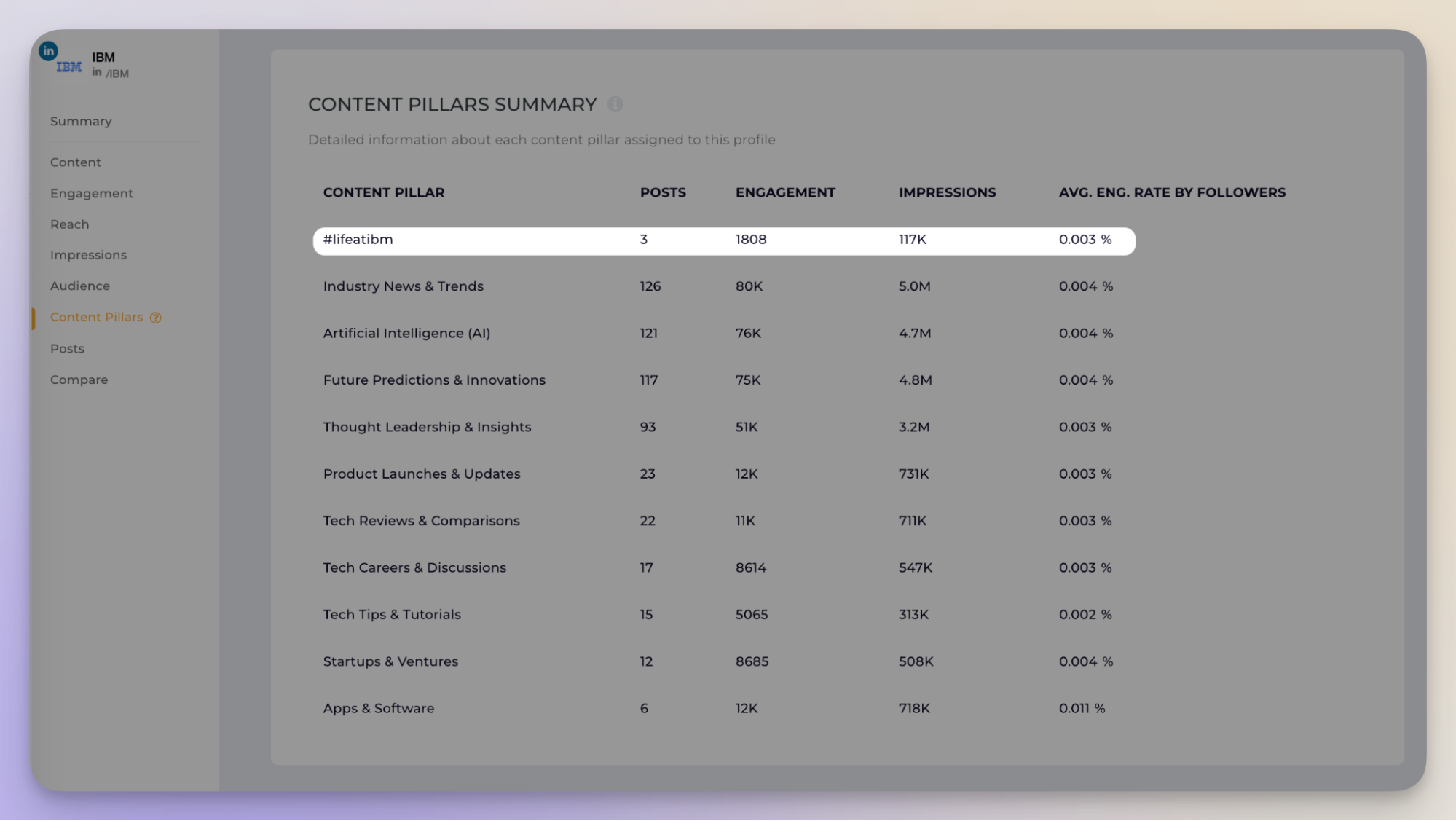
Final thoughts
Employee-generated content (EGC) is more than just a trend. It’s a powerful way to build trust, showcase company culture, and widen your brand’s reach.
When employees share their experiences, it feels real, relatable, and engaging. The best part? It benefits both the company and the employees by strengthening brand advocacy and personal branding.
To make the most of EGC, track its impact with the right tools. Socialinsider helps you measure performance effortlessly so you can see what’s working and refine your strategy.
Ready to take your EGC to the next level? Try Socialinsider today and start measuring success with ease!
Analyze your competitors in seconds
Track & analyze your competitors and get top social media metrics and more!
You might also like
Improve your social media strategy with Socialinsider!
Use in-depth data to measure your social accounts’ performance, analyze competitors, and gain insights to improve your strategy.



